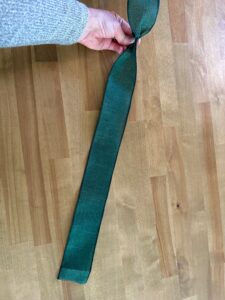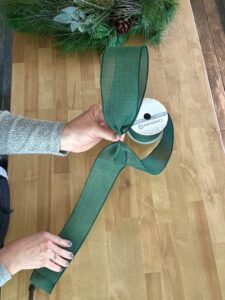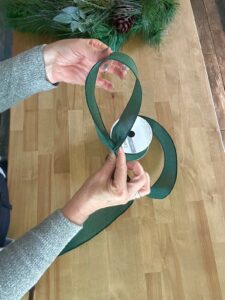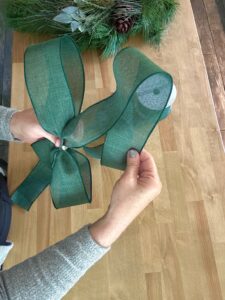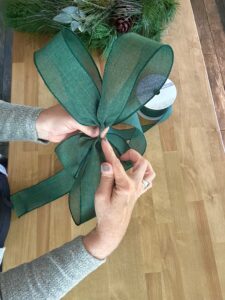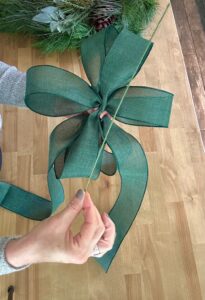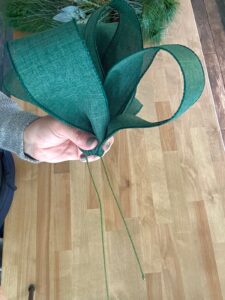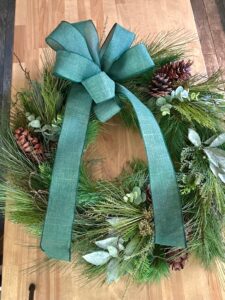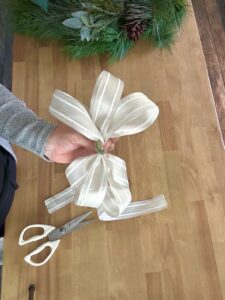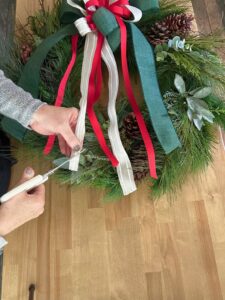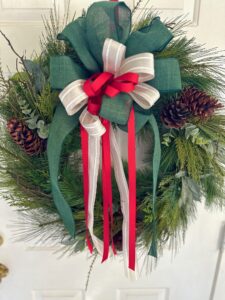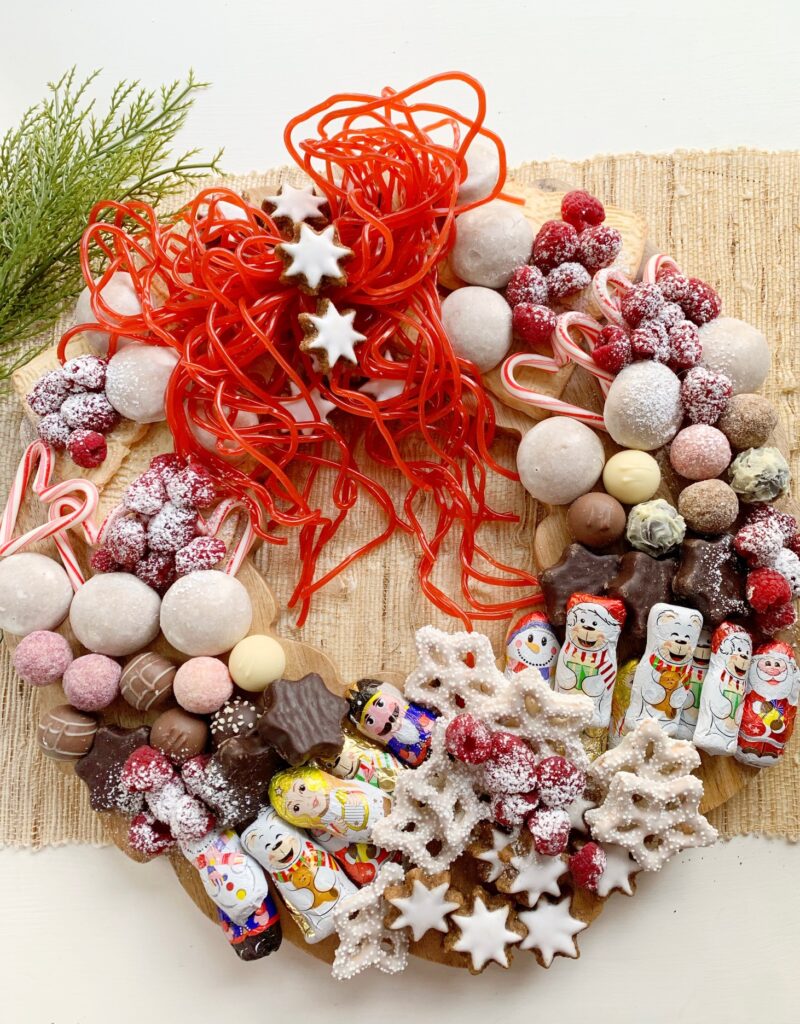Over my years as a floral designer, I've learned the secrets to making magazine-worthy bows for wreaths. Whether you're aiming for elegant simplicity or show-stopping drama, the key is in the technique and materials. From mastering the perfect loop in a classic single-ribbon bow to layering multiple ribbons and textures for an over-the-top creation, I'll guide you through crafting DIY wreath bows that will make your decorations truly stand out!
In this post, "Bow Making for Wreaths: Your Ultimate Guide to Simple and Layered Designs" I'm going to guide you through everything you need to know about bow making, from basic to advanced techniques. Here's what we'll cover:
- Basic bow making techniques for beginners
- Choosing the right ribbon(s) for your project
- Step-by-step instructions for creating a stunning bow
- Tips for working with wired and non-wired ribbons
- How to determine the perfect bow size for your wreath
- Troubleshooting common bow-making problems
- Creative ideas for using your beautiful bows
- Advanced techniques to take your bow-making skills to the next level
Whether you're just starting out or looking to enhance your bow-making skills, this comprehensive guide has something for everyone. Get ready to create bows that will make your wreaths, gifts, and decor stand out! Let's dive in and start crafting some bow magic!

This Bow Making for Wreaths post may contain affiliate links. When you shop the links, we receive a small commission at no cost to you. Thanks for supporting my small business.
Jump to:
- Bow making basics: Simple vs. layered
- Choosing your ribbon
- Choosing the perfect bow-tying material
- Determining the right bow size for your wreath
- Choosing the perfect bow placement
- Tailoring your bow tails: Tips and techniques
- Supplies to make a layered wreath bow
- Step-by-step instructions
- Bow Making for Wreaths: From Simple to Layered Designs
- Troubleshooting
- Frequently asked questions
Bow making basics: Simple vs. layered
In this guide, we'll cover techniques for both simple and layered styles, allowing you to choose the perfect bow for your project. Whether you're a beginner looking to master the basics or an experienced crafter aiming to create show-stopping designs, we've got you covered.
Simple bows, made with a single ribbon, offer a classic and elegant look. They're quick to create and perfect for everyday decorations or when you want a clean, understated aesthetic. These bows are ideal for beginners and can be easily customized with different ribbon widths or textures.
Layered bows, on the other hand, combine multiple ribbons to create a more complex and visually striking design. By using ribbons of varying widths, colors, and textures, you can craft a bow that truly stands out. While more intricate, these layered masterpieces add a professional touch to your wreaths, making them perfect for special occasions or when you want to make a bold statement.
Throughout this tutorial, we'll walk you through the steps for creating both simple and layered bows, providing tips and tricks to help you achieve beautiful results every time. Let's get started on your bow-making journey!

Linking a similar wreath.
Choosing your ribbon
For a simple bow
When selecting ribbon for a simple bow, focus on a single ribbon that complements your wreath or decor. Choose a width that suits the size of your project - wider ribbons (2-3 inches) work well for larger wreaths, while narrower ribbons (1-1.5 inches) are perfect for smaller arrangements. Consider the texture and finish of the ribbon as well; wired ribbons offer more structure and are easier to shape.
For a layered bow
When making a layered bow, it's important to think about how you'll match the ribbons to your decor or project. Using 3 different types of ribbon thicknesses and patterns creates interest and texture.
Consider grabbing one ribbon that matches or complements your existing color scheme. Then pick two more options with varying prints and textures to really make your bow pop.
Don't be afraid to get creative with patterns! Plaid ribbon, stripes, paisleys, and florals all pair beautifully when layered. Just be sure there is enough contrast between prints and ribbon colors so they don't blend together.
Or go with a monochromatic bow using all the same color tones but different textures.

Next, I'll discuss the difference between wired and non-wired ribbons and how that impacts working with them. But first, have fun collecting three gorgeous ribbons in an array of widths and designs! This is your chance to showcase your unique style.
Wired ribbon vs. Non-wired Ribbon
When bow making for wreaths, I recommend using a ribbon that's wired. The wire allows you to really shape the loops and tails, bending them to your will. It makes it easy to fluff and style a structured base bow.
Non-wired ribbons can be a bit more challenging to work with since they're so soft and floppy. But don't count them out! The key is getting the "pinch" at the center of the bow just right to add volume. And you may need to make additional loops so it's not too droopy.
The beauty of a layered bow is that each layer supports the next. So even if one ribbon is thin and non-wired, placing it over a sturdy wired base bow helps it keep its shape.

In this photo, the black and cream striped ribbon is not wired and appears a bit floppy, but it is supported by the wired ribbon layers beneath it.
When shaping non-wired ribbon, it likely won't hold crimps or a curly tail shape. But you can still notch the ends for a pretty look. The options are endless when combining different textures!
The wired ribbon, my favorite ribbon, will allow you to bend the loops to perfection and really control the look. But don't be afraid to get creative with softer ribbons too. Just focus on pinching each loop tight and making fuller bows. Together, the layers will support each other and create a showstopping finished product!

In the stack of ribbon rolls above the green and beige striped ribbon are wired, but the red is not.
To determine if a ribbon is wired, you can follow these steps:
- Examine the Edges: Gently bend the ribbon's edge. If it holds its shape and feels slightly rigid or firm, there's a good chance it contains a wire.
- Look for Wrinkles: Wired ribbons often have a slightly wrinkled appearance along the edges due to the wire inside.
- Check for Flexibility: Non-wired ribbons are generally more flexible and don't hold shapes as well as wired ones.
- Read the Label: If you have the ribbon's packaging or label, it might indicate whether it's wired or not.
- Consult the Seller: If you're unsure, consider reaching out to the seller or manufacturer for information on the ribbon's construction.
Remember that wired ribbons are commonly used in crafts, floral arrangements, and gift wrapping because they can be shaped and styled easily.

Choosing the perfect bow-tying material
When it comes to tying a handmade DIY wreath bow, you've got a few options: wire, string, or even a spare piece of ribbon can do the trick. Personally, I'm a fan of using flocked wired for this job. What's that, you ask? Well, flocked wired is like regular wire, but with a nifty fuzzy coating that gives it a bit of extra grip. This means it holds onto the ribbon like a pro, making your bows look even more fabulous. A pipe cleaner will have the same effect.

Determining the right bow size for your wreath
Are you wondering how to choose the perfect bow size for your Christmas wreath? It's a common question, and we have a simple method to help you get it just right based on your wreath's dimensions.
Step 1: Measure Your Wreath
Start by measuring the diameter of your wreath. This is the width of the wreath across its widest point, from one side to the other.
Step 2: Calculate the Bow Size
A beautifully proportioned bow typically ranges from ¼ to ⅓ of the wreath's diameter. To determine your bow size, use the following formulas:
- For a Smaller Bow: Multiply the wreath's diameter by 0.25. This will give you a bow size that's modest yet charming.
- For a Slightly Larger Bow: Multiply the wreath's diameter by 0.33. This is perfect if you want a bow that stands out a bit more.
Example: If your wreath measures 12 inches in diameter:
- For a Smaller Bow: 12 inches x 0.25 = 3 inches
- For a Slightly Larger Bow: 12 inches x 0.33 = 4 inches
Following this formula ensures your bow complements the wreath's size harmoniously, neither overshadowing it nor appearing too small. Keep in mind that personal style preferences and the overall design of your wreath can also influence your choice of bow size. This guideline serves as a helpful starting point, allowing you to customize your bow size based on your wreath and aesthetic preferences. This formula works for all kinds of wreaths.
Remember, A beautifully proportioned bow typically ranges from ¼ to ⅓ of the wreath's diameter.

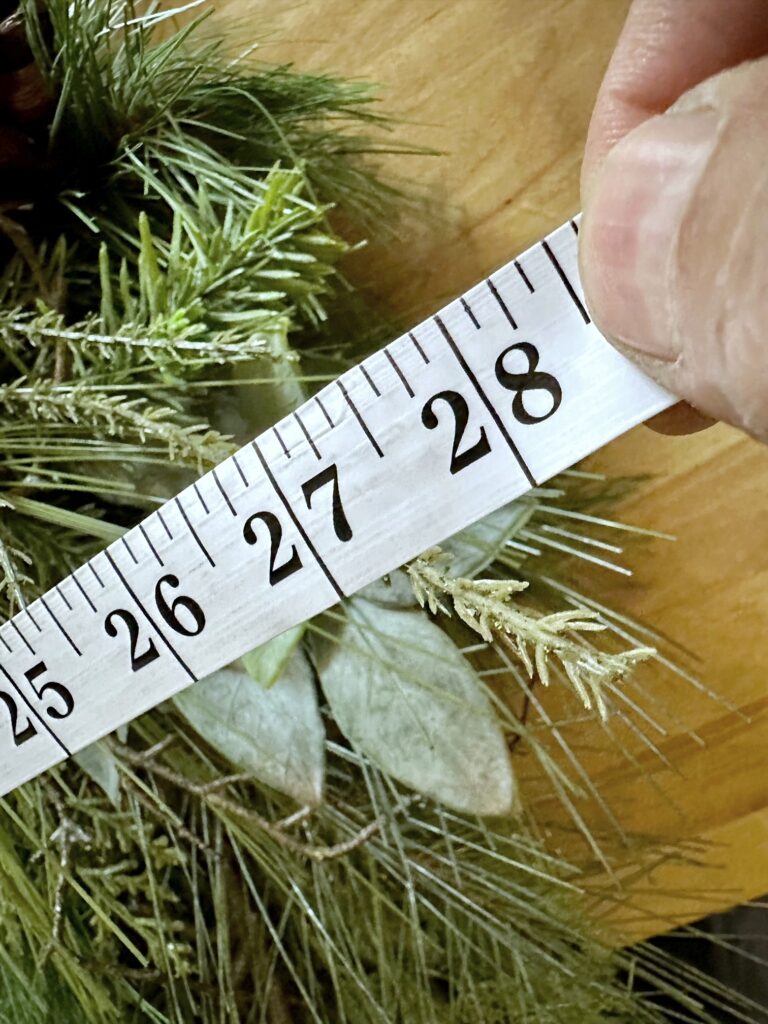
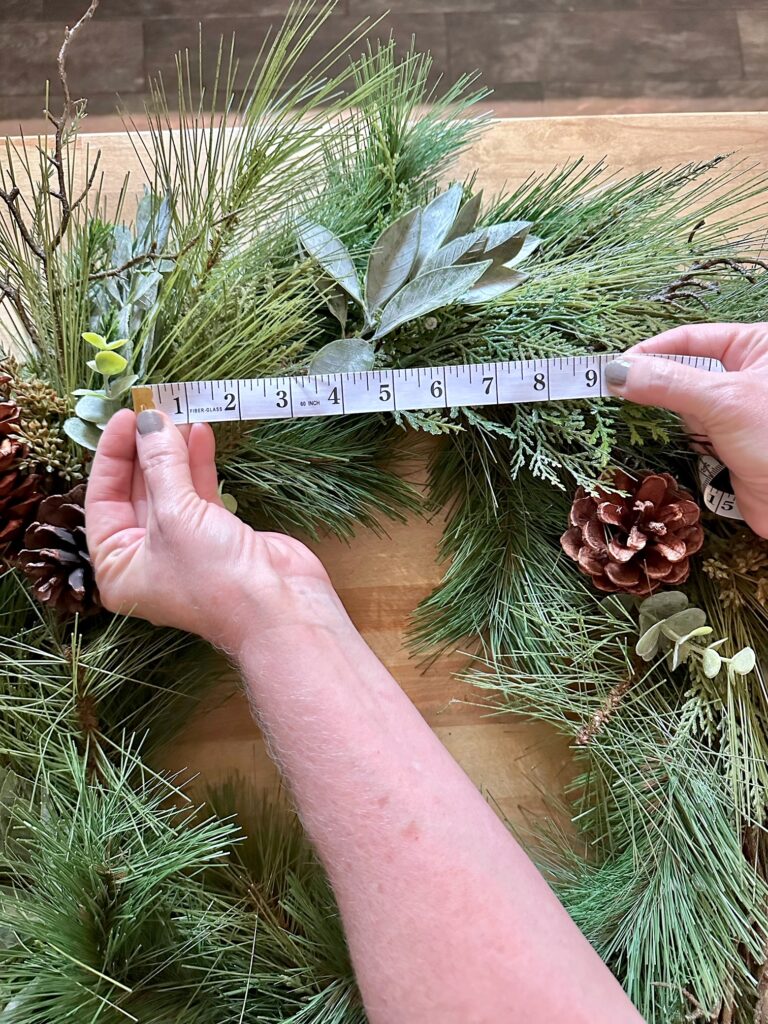
In the sample above, the wreath measured 28" across. One-third of 28" is 9.3", which should be your starting point for the bow size.
Choosing the perfect bow placement
Once you've created your beautiful bow, the next step is deciding where to place it on your wreath. While there's no strict rule, here are some popular options to consider:
Top of the wreath
This is the traditional placement and often creates a classic, balanced look. It makes the bow a focal point and allows for cascading tails to elegantly frame the wreath.
Bottom of the wreath
For a unique, modern twist, try placing your bow at the bottom. This can be especially effective if you have other decorative elements at the top of your wreath.
Side of the wreath
An asymmetrical design with the bow on one side can create an interesting, eye-catching look.
Remember, the best placement often depends on your wreath's overall design and your personal style. Don't be afraid to experiment with different positions to see what looks best with your specific wreath!
Tailoring your bow tails: Tips and techniques
Measuring for perfect tails
Creating beautiful tails for your DIY wreath bow is all about precision and style. To measure the tails accurately, hold a length of ribbon against your gift or decoration, allowing for some extra length to create the desired tail length.
Cutting techniques for stylish ends
When it's time to cut, you have a choice to make. Cutting the tails diagonally provides a classic and elegant look, while experimenting with other shapes, such as V-shaped or fishtail tails, can add a unique twist to your design.
Creating extra-long tails
If you're aiming for very large loops, make a loop with your ribbon, cut it at the desired length, and then separate the loop into two tails.
Adding "fake tails" for extra flair
And if you want to add "fake tails" for an extra flourish, simply tie in a long strand of ribbon after creating the bow. This versatile approach allows you to have tails of any length and style you desire, adding a touch of elegance and creativity to your bow-tying expertise.
Layered by tails
For this layered bow, you will have 3 sets of tails. You will be able to cut the ends of the ribbon so the tails are different lengths.
Adjusting tail length for different bow placements
When placing your bow at the bottom or side of the wreath, consider shortening the tails. Long, cascading tails that work beautifully for top-placed bows may overwhelm the design when positioned elsewhere. For bottom-placed bows, shorter tails prevent them from dragging or looking untidy. Similarly, for side-placed bows, asymmetrical tail lengths (shorter on one side) can create a more balanced look. Remember, you can always trim the tails after placing the bow on your wreath to achieve the perfect proportion for your specific design.

Supplies to make a layered wreath bow
- 3 types of ribbon:
- 1 roll Green wide wired ribbon (2.5" wide)
- 1 roll Cream wired stripe ribbon (1.5" wide)
- 1 roll Red grosgrain ribbon (⅝" wide)
- Scissors
- Flocked Wire (or other wire or pipe cleaners)
- Wreath form (optional)
Ribbon Length:
For a standard 24-inch wreath, you'll need about 3-4 yards of each ribbon for a basic bow. If you're making a fuller, more elaborate bow or working with a larger wreath, plan on using 5-6 yards or more of each ribbon. It's always better to have a little extra ribbon than to run short.
Step-by-step instructions
Bow Making for Wreaths: From Simple to Layered Designs
Equipment
- 1 Pair of scissors
- 3 pcs flocked (or papered floral wire) 16" wire Or other long piece of wire. Pipe cleaners work too.
Materials
- 1 Roll 2.5" wide ribbon (it is recommended to use wired ribbon)
- 1 Roll 1.5" coordinating ribbon
- 1 Roll ⅝" coordinating ribbon
- 1 piece 24" - 30" wreath (use artifical or real)
Instructions
- Gather your supplies. Begin by placing the widest roll of ribbon on the wreath where you want the bow to be located.

- Unroll the ribbon from the roll, allowing it to hang down to the bottom of the wreath. This will determine the length of your bow's tails.

- Using your index finger and thumb, pinch the ribbon above the desired tail length. To pinch simply gather the width of the ribbon and pinch and hold it between your fingers and thumb.

- With the pinch held between your fingers, make a 5" loop by bringing the ribbon up and then loop towards the back of the pinch. This forms the first loop above the pinch.

- Pinch the base of the loop with the ribbon that is pinched and held with your fingers.

- This photo shows a side view of the first loop and the finger placement for the pinch.

- Make the second loop beneath the pinch, ensuring it is approximately the same size as the first loop (usually about 5 inches).

- Continue making loops in the same manner, alternating between loops above and below the pinch. Create a total of 4 top loops and 3 bottom loops.

- For a full bow, be sure to continue to pinch the ribbon in the center of the bow as you go by laying each loop next to the one before it.

- This photo depicts the full bow with 4 top loops and 3 bottom loops.

- Take one 16" piece of flocked wire to secure the bow.

- Slide 7" of the wire down next to the pinch while continueing to pinch.

- Wrap a piece of floral wire over the pinch and bring down the opposite side.

- Flip the bow and push the loops forward, then twist the ribbon tightly on the back of the pinch.

- Flip the bow back to the front, and it should now be nicely secured with the wire.

- Cut the second tail from the remaining roll of ribbon at the same length as the first tail.

- Affix the bow to the top of the wreath using the wire either by wrapping or poking the wire through and wrapping it around the wreath base. For a simple bow you will want to stop there! Continue on for a layered bow.

- Take your 1.5" ribbon and repeat the steps above to make a second bow. Make your loops smaller (3"-4")

- Affix the bow to the top of the first bow by poking the wire through the wreath on either side of the first bow. Then wrap the wire on the back of the wreath to secure.

- Take your ⅝" ribbon and repeat the steps above to make a third bow. Make your loops smaller (3")

- Affix the third bow to the top of the second bow by poking the wire through the wreath on either side of the second bow. Then wrap the wire on the back of the wreath to secure.

- To finish, trim the ends of the ribbon. You can either cut them on a slant for a classic look or create a fish-tail cut for a more decorative finish.

- Finally, fluff the bow by adjusting and shaping the loops until you achieve your desired bow shape and fullness.

Notes
Still need help? Try this easy way to create amazing bows: use an Ez bow maker. This bow-making tool helps you craft your own bows effortlessly. With practice, you'll be making a stunning, professional-looking perfect wreath bow in no time.
Troubleshooting
Even seasoned bow makers encounter occasional hiccups in their crafting journey. Don't worry; here are some common issues and expert tips to help you get your bow back on the path to perfection:
- Limp, Floppy Bow: If your DIY wreath bow lacks the desired structure, consider using wired ribbon, which offers excellent support. Alternatively, adding starch to your ribbon can help it hold its shape better. Make sure your initial loops are sufficiently large, secure the center knot tightly with wire or a zip tie, and don't hesitate to add more loops to enhance fullness and fluffiness.
- Uneven Loops: Achieving uniform loop sizes is crucial for a well-balanced bow. Start by carefully cutting your ribbon lengths evenly. Take your time to fluff and shape each loop, adjusting any that appear too large or small. Maintain precision in forming knots and pinching centers. If needed, you can trim uneven loops to create stylish "in bow" tails, often cut short and in a dovetail shape.
- Tails Not Staying Curled or in Place: To maintain beautifully curled tails, especially with wired ribbon, try wrapping the ribbon ends around a pencil and shaping them as desired. When using glue to secure the ends, apply only a small dot and avoid flattening the curl. For added durability, consider inserting florist wire into the ribbon ends. This extra reinforcement ensures your tails stay in their elegant curls.
- Bow Won't Stay On Wreath: To keep your DIY wreath bow securely in place on a wreath, double-check that the wire or pipe cleaner is tightened firmly. If using hot glue to attach the back of the bow to the wreath's surface, ensure a thorough application on both the wreath and the bow's back. For added stability, you can even consider inserting pins into the wreath form to provide extra hold, ensuring your bow remains the centerpiece of your creation.
With some small adjustments, you can troubleshoot any bow frustrations. Just focus on tightening centers, evening out loops, stiffening limp ribbons, and properly securing the bow for long lasting beauty.

Frequently asked questions
To make the perfect bow for a wreath, start by choosing the right ribbon width for your wreath size. Create even loops, making sure to pinch the center tightly. For a basic bow, make 2-3 loops on each side. Secure the center with wire, then fluff and shape the loops. For a more elaborate bow, consider using the layering technique: create multiple bows using different ribbons, then stack them together, adjusting the loop sizes for each layer to create a full, professional look. This method allows you to combine various colors, textures, and widths for a truly stunning result. Visit my Green and White Christmas Decor post to see one of my layered bows on a beautiful lantern!
The amount of ribbon needed depends on the size of your wreath and the fullness of the bow you want to create. As a general rule, for a standard 24-inch wreath, you'll need about 3-4 yards of ribbon for a basic bow. For a fuller, more elaborate bow or larger wreaths, you might need 5-6 yards or more. It's always better to have a little extra ribbon than to run short.
The number of loops in a wreath bow can vary depending on the desired fullness and the size of your wreath. For a simple bow, 4-6 loops (2-3 on each side) are usually sufficient. For a fuller, more elaborate bow, you might create 8-12 loops or even more. Remember, you can always add more loops to increase the bow's volume and impact.
For a 30-inch wreath, you'll want a bow that's proportional to the wreath's size. A good rule of thumb is to make your bow about ¼ to ⅓ the diameter of your wreath. For a 30-inch wreath, this means your bow should be approximately 7.5 to 10 inches wide. Use ribbon that's 2.5 to 3 inches wide for the main loops to create a bow that complements the wreath's scale.
The placement of a bow on a wreath is largely a matter of personal preference and the overall design of your wreath. Traditionally, bows are placed at the top of the wreath, which can create a classic, balanced look. This positioning also makes the bow a focal point and allows for cascading tails to frame the wreath beautifully. However, placing a bow at the bottom can create a unique, modern look and may be preferable if you have other decorative elements at the top of your wreath. Some people even place bows on the side for an asymmetrical design. Experiment with different placements to see what looks best with your specific wreath design.
You can find a variety of ribbons for your craft projects at craft stores, online retailers like Amazon and Etsy, fabric stores, and even local boutiques. A craft store like Hobby Lobby is especially great for seasonal ribbons during the holiday season. Don't hesitate to explore these options to discover your favorite ribbons for your creative endeavors!
The best ribbon for wreaths depends on several factors, including the style of your wreath, the season, and whether the wreath will be indoors or outdoors. Here are some popular choices:
Grosgrain ribbon: Known for its ribbed texture, grosgrain is durable and holds its shape well. It's versatile and works for both casual and formal wreaths.
Wired ribbon: This is often considered the best all-around choice as it holds its shape well and is easy to manipulate into loops and bows.
Weather-resistant ribbon: If your wreath will be outdoors, look for ribbons made of materials like polypropylene that can withstand the elements.
Burlap ribbon: Great for rustic or farmhouse-style wreaths.
Satin or silk ribbon: These work well for elegant, indoor wreaths.
Mesh ribbon: Popular for fuller, more casual wreaths, especially for holidays.
Velvet ribbon: Adds a luxurious touch, perfect for winter or holiday wreaths.
The width of the ribbon is also important - 2.5 to 3 inches wide is typically a good size for most wreaths. Whatever you choose, make sure it complements the other elements of your wreath and suits the overall style you're aiming for.

And there you have it - all the secrets to crafting a showstopping beautiful bow! With the right combination of wired and non-wired ribbons, strategic layering techniques, and a dash of creativity, you can now make professional-quality bows to elevate any decor or gift.
The key is taking your time to choose the best ribbon, pinch each loop tight, evenly space and shape layers, and securely attach your bow for maximum longevity. Troubleshooting limp ribbons or uneven loops is a breeze with the tips provided.

So grab your favorite ribbons and let your imagination run wild! A beautiful ribbon bow adds that special handmade touch and luxury feel to wreaths, presents, flower arrangements like my lily topiary, and beyond. I hope you enjoyed learning how to create these stunning bows. Wow your loved ones with your new amazing bow making abilities.
Add a fabulous bow to any of these projects:
- Add a pretty bow to your china plate wreath for that perfect pop of color and charm
- Wrap your DIY book stacks with simple ribbon bows to make them look extra special
- Top off your tulip wreath with a handmade bow that takes it from nice to wow-worthy
These quick projects are perfect for practicing your bow-making techniques while adding that special handmade touch to your home decor!
If you are ready to take your bow-making abilities to the next level visit:
Holiday Dessert Charcuterie Wreath Recipe (With Licorice Bow Instructions: Indulge in the holiday spirit with our Holiday Dessert Charcuterie Wreath Recipe, a sweet twist on the viral charcuterie board trend. We've transformed the classic wreath-shaped board into an edible masterpiece adorned with Christmas candies, cookies, and even heart-shaped candy canes, which you can easily make. Plus, we spill the beans on crafting the perfect licorice bow to complete the look.
Thank you for visiting the blog! I hope you found Bow Making for Wreaths: Your Ultimate Guide to Simple and Layered Designs helpful!
Happy crafting friends!






